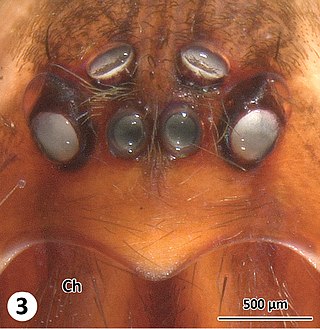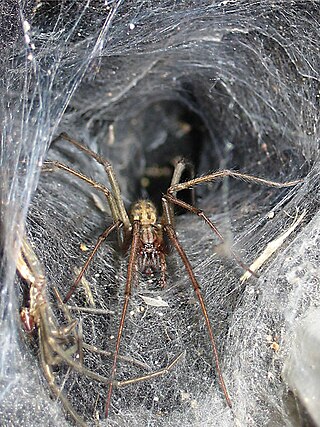
The Araneomorphae are an infraorder of spiders. They are distinguishable by chelicerae (fangs) that point diagonally forward and cross in a pinching action, in contrast to the Mygalomorphae, where they point straight down. Araneomorphs comprise the vast majority of living spiders.

Lampshade spiders, family Hypochilidae, are among the most primitive of araneomorph spiders. There are two genera and twelve species currently recognized. Like mygalomorphs, most hypochilids have two pairs of book lungs, but like araneomorphs they have intersecting fangs, with the exception of some species which have chelicerae in an angle that is neither orthognathous or labidognathous. These long-legged spiders build typical "lampshade" style webs under overhangs and in caves. In the United States the fauna is primarily associated with the Appalachian, Rocky and California Mountains. Ten of the known species are found in these ranges, all in the genus Hypochilus. The genus Ectatosticta is found in China.
Kaiya is a genus of Australian large-clawed spiders that was first described by Raymond Robert Forster, Norman I. Platnick & Michael R. Gray in 1987.

Norman Ira Platnick was an American biological systematist and arachnologist. At the time of his death, he was a professor emeritus of the Richard Gilder Graduate School and Peter J. Solomon Family Curator Emeritus of the invertebrate zoology department of the American Museum of Natural History. A 1973 Ph.D. recipient at Harvard University, Platnick described over 1,800 species of spiders from around the world, making him the second most prolific spider taxonomist in history, behind only Eugène Simon. Until 2014 he was also the maintainer of the World Spider Catalog, a website formerly hosted by the AMNH which tracks the arachnology literature, and attempts to maintain a comprehensive list, sorted taxonomically, of every species of spider which has been formally described. In 2007 he received the International Society of Arachnology's Bonnet award, named for Pierre Bonnet, in recognition of his work on the catalog.

Huttoniidae is a family of ecribellate araneomorph spiders containing a single genus, Huttonia, itself containing a single described species, Huttonia palpimanoides. It is known only from New Zealand.

Austrochilidae is a small spider family with nine species in two genera. Austrochilus and Thaida are endemic to the Andean forest of central and southern Chile and adjacent Argentina.

Gradungulidae, also known as large-clawed spiders, is a spider family endemic to Australia and New Zealand. They are medium to large-sized haplogyne spiders with three claws and two pairs of book-lungs similar to Mygalomorphae. Some species build extensive webs with an upper retreat tangle and connecting threads to scaffolding. This supports the ladder-like catching platform that is glued to the ground. Progradungula, a large spider with long legs like Hickmania, and Macrogradungula are the only cribellate genera of the family.

Progradungula is a genus of Australian large-clawed spiders that was first described by Raymond Robert Forster and Michael R. Gray in 1979. As of May 2024 it contains only three species: P. barringtonensis, P. carraiensis and P. otwayensis.

Gradungula is a monotypic genus of South Pacific large-clawed spiders containing the single species, Gradungula sorenseni. It is only found in New Zealand.

The Agelenoidea or agelenoids are a superfamily or informal group of entelegyne araneomorph spiders. Phylogenetic studies since 2000 have not consistently recovered such a group, with more recent studies rejecting it.

The Austrochiloidea or austrochiloids are a group of araneomorph spiders, treated as a superfamily. The taxon contains two families of eight-eyed spiders:

Romnalda is a genus of monocotyledonous plants in the family Asparagaceae, subfamily Lomandroideae. As of December 2013 four formally named species are known and accepted by botanical science.

Spelungula is a monotypic genus of South Pacific large-clawed spiders containing the single species, Spelungula cavernicola, or the Nelson cave spider.

Progradungula otwayensis, commonly known as the Otway odd-clawed spider, is a species of cribellate spider endemic to the Great Otway National Park of Victoria, Australia. It is one of only three species in the gradungulid genus Progradungula.

Austrarchaea is a genus of Australian assassin spiders first described by Raymond Robert Forster & Norman I. Platnick in 1984. 25 species were described by Michael Gordon Rix and Mark Stephen Harvey in 2011, 2012, and 2024.

Pianoa is a monotypic genus of large-clawed spiders endemic to New Zealand. It contains a single species, Pianoa isolata, known commonly as the piano flat spider.
Tarlina is a genus of Australian large-clawed spiders that was first described by Raymond Robert Forster, Norman I. Platnick & Michael R. Gray in 1987.
Gippsicola is a genus of Australian tube dwelling spiders that was first described by Henry Roughton Hogg in 1900. It is no longer considered a junior synonym of Segestria due to anatomical differences in the pedipalps of males and the receptaculum in females.
Anopsolobus is a monotypic genus of Polynesian araneomorph spiders in the family Orsolobidae containing the single species, Anopsolobus subterraneus. It was first described by Raymond Robert Forster & Norman I. Platnick in 1985, and is only known from Nelson in New Zealand.













